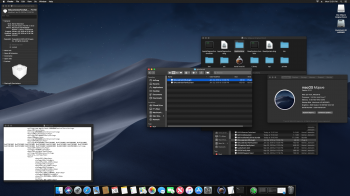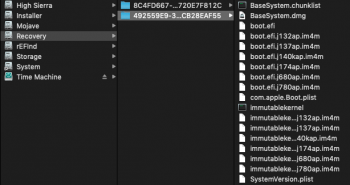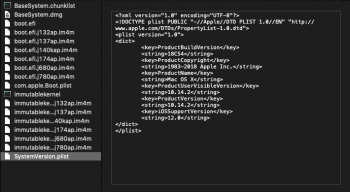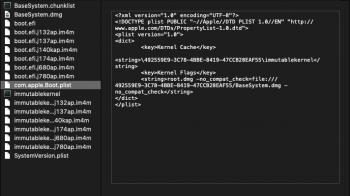Got a tip for us?
Let us know
Become a MacRumors Supporter for $50/year with no ads, ability to filter front page stories, and private forums.
macOS 10.14 Mojave on Unsupported Macs Thread
- Thread starter dosdude1
- WikiPost WikiPost
- Start date
- Sort by reaction score
You are using an out of date browser. It may not display this or other websites correctly.
You should upgrade or use an alternative browser.
You should upgrade or use an alternative browser.
- Status
- The first post of this thread is a WikiPost and can be edited by anyone with the appropiate permissions. Your edits will be public.
Yeah, it seems the legacy graphics hardware has weird issues with external displays/clamshell mode under Mojave... Unfortunately there's really nothing that can be done about that.
How about creating a patch that move every app to the external display! it's frustrating, that I need to open the led to move the app/browser windows to the external display :'(
Failed to upgrade to the 10.14.4 Beta 1 on my unsupported MBs (MBPro5,3 and MBAir4,2).
After several attempts over the weekend, with suggestions from @carld, @jackluke and @Badruzeus, all efforts unfortunately failed. I will try again when 2nd beta comes in.
At least I have the beta 1 installed on a supported Mac (MacMini late 2012). I will continue my testing on this machine.
Thanks again all and specially to the 3 I mentioned above for their suggestions.
Regards.
Sorry for late reply.
I believe it' s not bcoz Metal incapable graphics; my Nvidia Fermi GF119 is still running well with full gfx accel under 10.14.4 Beta 1. Seems like something else which prevents LoginUI (or WindowServer) to be loaded, it' s bit hard to know what is it w/o any log. Not sure with Intel HD 1st Gen & HD3000, having similar issue with 10.14.4 Beta?
So I was poking around at the loaded kexts today, trying to see if there was anything to be done with the lack of acceleration on a couple 6970 equipped iMacs I have here when I saw that although the 6000 controller and associated kexts for it were loaded that the IOAccelerator2D.plugin and IOAcceleratorFamily2.kext were the original ones from the installation and not the ones in the "gfxshared" folder inside the Post-Install app.
I copied those two files over and replaced the originals that were in System/Library/Extensions and rebooted...
On reboot I found that I did not have the "inverted" color issue and I didn't have the almost unusable window issues, like disappearing contents when dragging or artifacting. It's definitely not as snappy as a fully accelerated card - but short of replacing the internal 6970 with a 4XXX series card from an older iMac I think it's as good as I'm going to get on these.
This was on a Mid 2011, 27 inch and I used the original patcher and first retail release. I'm going to try the same thing with the updated patcher and 14.3 on another nearly identical machine and verify it works with that too...
I copied those two files over and replaced the originals that were in System/Library/Extensions and rebooted...
On reboot I found that I did not have the "inverted" color issue and I didn't have the almost unusable window issues, like disappearing contents when dragging or artifacting. It's definitely not as snappy as a fully accelerated card - but short of replacing the internal 6970 with a 4XXX series card from an older iMac I think it's as good as I'm going to get on these.
This was on a Mid 2011, 27 inch and I used the original patcher and first retail release. I'm going to try the same thing with the updated patcher and 14.3 on another nearly identical machine and verify it works with that too...
What changed in the 10.14.1/10.14.2 updates, or the updated version of the Mojave Patcher that gimped the 5770 almost completely? I'm using a Mac Pro 3,1 and if I do an install with the original patcher and the original retail release of 10.14 I can use the Legacy Graphics Patch and have a very snappy and usable system, but every time I've gone to 10.14.1 or 10.14.2 that goes out the window. I have done clean installs of each, I have tried to re-install the legacy video patch and rebuilt kext cache but nothing seems to work.
Any thoughts? I could do a re-install of the base version, but I'd prefer not to if I'm just missing something. Or I can toss my 8800 GT back in, but I lose a lot of 3d grunt with that little guy.
Thanks!
Attachments
You are on the right track, but the CCFL backlight patch is something different from the one in the post-install patcher.Thank you Larsvonhier,
Now I have reinstalled 10.14.3 and my iMac 8,1 starts properly after applying the "macOS Post Install" and selected force cache rebuild before rebooting. but still no backlight control with F1/F2 (only the display works with F1/F2 but does not control the backlight). I really wonder if the backlight patch should not be applied. But it automatically applies with "macOS Post Install". How to make it not apply?
Under High Sierra the backlighting controlled by F1/F2 works fine and I also have the folder "Bklt_Backup" and "CoreBrightness-Backup" so I guess the patch was also applied under High Sierra.
View attachment 818605 View attachment 818606
I confirm, under High Sierra backlight control was patched for the iMac 8,1 (I find that the information of the "macOS Post Install" High Sierra to indicate what each patch does is great but unfortunately it is not is no longer the case with "macOS Post Install" from Mojave ...)
View attachment 818667 View attachment 818668
You should only apply the latter on an iMac8,1 (and others)
Also note that you can always disable single patches but once patched, some cannot be undone by re-patching again.
You could try to run patchupdater on a running system and (independently what that tool reports) just re-install patches from there.
This helped on one of my macbooks (5,2) where I could not get backlight control otherwise...
Unluckily as I wrote before, each one use custom disks partitioning and the APFS Recovery mount point could vary, so that's why it's hard to write an universal script for it.
Boot normally Mojave, launch Terminal and type:
diskutil list
diskutil apfs list
Report here your current disks/partitions scheme, and I'll try to help you to pass the CMD+R prohibitory symbol.
A PDF of the results is included. Screenshots of the result after running my script on my Recovery partition are included. My Recovery partition is disk2s3.
Attachments
For anyone who installed a beta of 10.14.4, what is the Darwin kernel version?
Thanks I downloaded from App Store and patched again. Thanks... I did not know about if disk is not APFs it would not update from software update...Hi,
If your disk is not formatted in APFS it's normal!
In order to download you have to go to AppStore here is the link: https://itunes.apple.com/en/app/macos-mojave/id1398502828?mt=12
This gives the full version to be able to create a USB installation key with Dosdude Patcher 1.2.3 (thanks to him).
Or go to the Apple website to download the update:
http://updates-http.cdn-apple.com/2...88-11E8-B555-8E91F34A5CAA/macOSUpd10.14.3.dmg
Do not forget to restart "macOS Post Install" from your USB flash drive and select "force cache rebuild" before rebooting.
Maybe I could make an updated version of my old Update Installer script and test that.No worries, it seems till now no one succeeded in booting 10.14.4 beta on unsupported macs, so it will be field of study until a full installer release will come.
edit:
apart carld that succeeded in 10.14.4 beta, but I think the late 2011's mac series are all almost natively supported platforms in my humble opinion, that's why they encounter less issues during upgrades and require less patches, probably to boot they only require -no_compat_check, they work even with the original Mojave telemetry plugin, and sometimes BT/Wifi and USB kext are natively detected too.
For anyone who installed a beta of 10.14.4, what is the Darwin kernel version?
System Version: macOS 10.14.4 (18E174f)
Kernel Version: Darwin 18.5.0
Last edited:
A PDF of the results is included. Screenshots of the result after running my script on my Recovery partition are included. My Recovery partition is disk2s3.
At first glance you have (as many of us) a very personal custom disk partitioning, you use one physical disk I guess 2 TB internal (for disk0-1-2-3-4) and another physical external 1 TB (for disk5-6 time machine), but I notice a weird thing an HighSierra installation in APFS on disk2s5 and inside the same container another "System" on disk2s1 (I guess it's Mojave and moreover you have a Filevault Enabled on it maybe also this could be the issue with CMD+R), then you have another slim Mojave installation in APFS on disk4s1 with another Mojave Recovery disk4s4 annexed, but I bet your main issue is due to the disk2s5 that infact has produced a double UUID inside your main /Volumes/Recovery/ path I mean the folder "8C4F...12C", so in your specific particular case I can't help you quickly, but I noticed also that you use "Refind", in this case you can easily boot the APFS Recovery selecting one of the two "lifebelt" icon available during your Refind bootloader countdown, meanwhile you will able to boot the APFS Recovery anyway from there.
Instead to continue to try to help you to use CMD+R, you should set a general system nvram variable with "-no_compat_check -v", I know many prefer to see the fancy apple logo but temporary you have to put the "-v" forcing the verbose boot, because only in this way you can see exactly what's behind the infamous prohibitory symbol.
[doublepost=1548714369][/doublepost]
Maybe I could make an updated version of my old Update Installer script and test that.
Yes you could but you need first a delta/combo 10.14.4 pkg , and OTA ones I guess don't fit well with your method.
Last edited:
Is there a patcher for 10.4.4 beta 1? I know I am being lazy and not reading all the latest posts. please indulge me.
Is there a patcher for 10.4.4 beta 1? I know I am being lazy and not reading all the latest posts. please indulge me.
Not guessing you update to this build; many Tesla users are having blackscreen issue.. and still, no success report from Intel HD3000 graphics & below. It's better waiting for the next Betas, could be bug with 18E174f.
I updated a MacMini 3,1 and it just wouldn't boot. I am back on 10.14.3Not guessing you update to this build; many Tesla users are having blackscreen issue.. and still, no success report from Intel HD3000 graphics & below. It's better waiting for the next Betas, could be bug with 18E174f.
Whoa, great work!! This looks like the first real progress on those old cards. @dosdude1 @parrotgeek1So I was poking around at the loaded kexts today, trying to see if there was anything to be done with the lack of acceleration on a couple 6970 equipped iMacs I have here when I saw that although the 6000 controller and associated kexts for it were loaded that the IOAccelerator2D.plugin and IOAcceleratorFamily2.kext were the original ones from the installation and not the ones in the "gfxshared" folder inside the Post-Install app.
I copied those two files over and replaced the originals that were in System/Library/Extensions and rebooted...
On reboot I found that I did not have the "inverted" color issue and I didn't have the almost unusable window issues, like disappearing contents when dragging or artifacting. It's definitely not as snappy as a fully accelerated card - but short of replacing the internal 6970 with a 4XXX series card from an older iMac I think it's as good as I'm going to get on these.
This was on a Mid 2011, 27 inch and I used the original patcher and first retail release. I'm going to try the same thing with the updated patcher and 14.3 on another nearly identical machine and verify it works with that too...
I am trying to apply the apfs ROM-patcher and I keep getting the message : "DirectHW.kext could not be loaded . The operation cannot proceed". The procedure I followed was: I turned off the machine, waited 15 sec, held down the power button until it blinks , 1 slow, multiple rapid flashes then one slow. The machine then boots as normal. I try to apply the patch. I correctly identifies my machine. It then gives the error above. I have an early 2008 15" MacBook Pro. I successfully upgraded to Mojave using the patcher on an SSD already converted to apfs It now boots using verbose boot patch. SIP is off.
I need help getting the ROM patcher to work. Thanks in advance
I need help getting the ROM patcher to work. Thanks in advance
Recovery works when I boot it from rEFIn and patch it with my script. Idk why but I can’t get CMD + R to work. I tried once with the NVRAM variable and it booted but the input devices weren’t working. I will release an update to my patcher and you can try part of the code on a normal partition map if you want. In my situation it just won’t work with CMD + R.At first glance you have (as many of us) a very personal custom disk partitioning, you use one physical disk I guess 2 TB internal (for disk0-1-2-3-4) and another physical external 1 TB (for disk5-6 time machine), but I notice a weird thing an HighSierra installation in APFS on disk2s5 and inside the same container another "System" on disk2s1 (I guess it's Mojave and moreover you have a Filevault Enabled on it maybe also this could be the issue with CMD+R), then you have another slim Mojave installation in APFS on disk4s1 with another Mojave Recovery disk4s4 annexed, but I bet your main issue is due to the disk2s5 that infact has produced a double UUID inside your main /Volumes/Recovery/ path I mean the folder "8C4F...12C", so in your specific particular case I can't help you quickly, but I noticed also that you use "Refind", in this case you can easily boot the APFS Recovery selecting one of the two "lifebelt" icon available during your Refind bootloader countdown, meanwhile you will able to boot the APFS Recovery anyway from there.
Instead to continue to try to help you to use CMD+R, you should set a general system nvram variable with "-no_compat_check -v", I know many prefer to see the fancy apple logo but temporary you have to put the "-v" forcing the verbose boot, because only in this way you can see exactly what's behind the infamous prohibitory symbol.
[doublepost=1548714369][/doublepost]
Yes you could but you need first a delta/combo 10.14.4 pkg , and OTA ones I guess don't fit well with your method.
@dosdude1 My MacBook 5,1 used to boot APFS volume natively after applying APFS patch but when I update my MacBook to 10.14.3 via OTA, apply patches and I forgot to uncheck the APFS Patch. I saw the scrolling text now. How can I uninstall that patch?
@dosdude1 My MacBook 5,1 used to boot APFS volume natively after applying APFS patch but when I update my MacBook to 10.14.3 via OTA, apply patches and I forgot to uncheck the APFS Patch. I saw the scrolling text now. How can I uninstall that patch?
Hi
This happened to me not so long ago, Flacko answered my call on page 462, #11538, which you could go back to, or
read this pasted from the answer.
If you have a successful ROM update then to remove the verbose output you will need to mount the efi drive. To find which one it is use:
In Terminal enter
sudo diskutil list
This will display your drives and you can identify the efi partition. In my case it is disk0s1. Then mount this partition:
sudo diskutil mount disk0s1
After a moment the efi drive should appear on your desktop. You can then use finder to delete the following: apfs.efi, /BOOT/BOOTX64.EFI and startup.nsh.
I would then boot back to your patcher USB and re install the patches for your machine, avoiding the APFS patch
Boot using Force Cache Rebuild, and it should be good to go.
I am trying to apply the apfs ROM-patcher and I keep getting the message : "DirectHW.kext could not be loaded . The operation cannot proceed". The procedure I followed was: I turned off the machine, waited 15 sec, held down the power button until it blinks , 1 slow, multiple rapid flashes then one slow. The machine then boots as normal. I try to apply the patch. I correctly identifies my machine. It then gives the error above. I have an early 2008 15" MacBook Pro. I successfully upgraded to Mojave using the patcher on an SSD already converted to apfs It now boots using verbose boot patch. SIP is off.
I need help getting the ROM patcher to work. Thanks in advance
I am not sure if you realize that ANY ADVICE given to you on this topic can result in your machine being bricked?
At least add to your comment that you don't really care about your machine and ready to put it in a trash(Or have tools and skills to de-solder and re-program the EEPROM chip/buy a new chip). Maybe then people will be able to give you some advice.
Yeah if anyone here wants to talk about rom modification, at minimum they should know what a Ch341a and SOIC8 clip is before posting. Also they can't get very far if DirectHW.kext isn't loading (Something is wrong with SIP). If you attempt something like this you need to be able to get your ROM (the tool backs it up to ~/Documents) off your dead mac by plugging the drive in as external. Pulling the ROM off it. Locating your EEPROM on your logic board and properly attaching the clip onto it and re-flash it on a PC. If anyone here has no clue what i'm saying, don't attempt APFS ROM-patcher.I am not sure if you realize that ANY ADVICE given to you on this topic can result in your machine being bricked?
At least add to your comment that you don't really care about your machine and ready to put it in a trash(Or have tools and skills to de-solder and re-program the EEPROM chip/buy a new chip). Maybe then people will be able to give you some advice.
Yeah if anyone here wants to talk about rom modification, at minimum they should know what a Ch341a and SOIC8 clip is before posting. Also they can't get very far if DirectHW.kext isn't loading (Something is wrong with SIP). If you attempt something like this you need to be able to get your ROM (the tool backs it up to ~/Documents) off your dead mac by plugging the drive in as external. Pulling the ROM off it. Locating your EEPROM on your logic board and properly attaching the clip onto it and re-flash it on a PC. If anyone here has no clue what i'm saying, don't attempt APFS ROM-patcher.
I guess it is a testament to a brilliant work that is done by dosdude1.
You don't need to have any PC knowledge whatsoever to successfully use his great tools, as long as you are smart enough not to get too "carried away" and know your limitations.
Recovery works when I boot it from rEFIn and patch it with my script. Idk why but I can’t get CMD + R to work. I tried once with the NVRAM variable and it booted but the input devices weren’t working. I will release an update to my patcher and you can try part of the code on a normal partition map if you want. In my situation it just won’t work with CMD + R.
For fixing usb input devices you should use/copy the dosdude1's Mojave Installer "prelinkedkernel" renaming into "immutablekernel" inside your APFS Recovery path, but I believe your issue is between Filevault Enabled and HighSierra-Mojave inside the same APFS container.
Otherwise try to patch your other APFS Recovery on disk4s4 probably it's the one associated to CMD+R by your last Mojave installation, because the last you install becomes the first blessed for macOS default booting.
[doublepost=1548756748][/doublepost]
Not guessing you update to this build; many Tesla users are having blackscreen issue.. and still, no success report from Intel HD3000 graphics & below. It's better waiting for the next Betas, could be bug with 18E174f.
Interesting, that apple maybe "fixed" with 10.14.4 the OpenGL loophole? We really hope no, they'd have more important stuffs to care about like ios and such.
I was reading at your crashing log: "failed to create MetalDevice for accelerator" related to the Skylight.framework, in this case as @carld replaced the previous "WindowServer" binary, 'd makes sense.
Last edited:
Thx . This means that the Dosdude1 app needs to be updated for this release. @dosdude1 is probably already aware of this.System Version: macOS 10.14.4 (18E174f)
Kernel Version: Darwin 18.5.0
Register on MacRumors! This sidebar will go away, and you'll see fewer ads.





